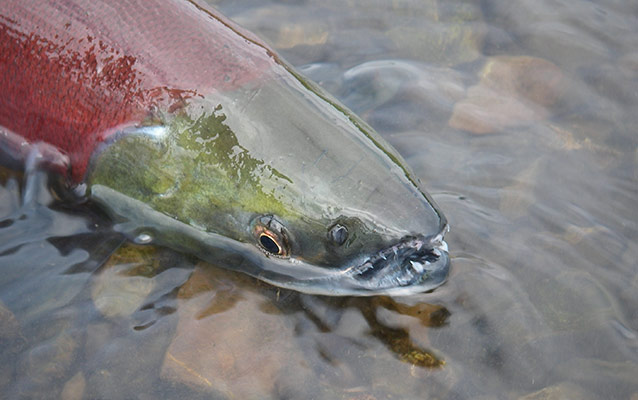Last updated: April 23, 2019
Lesson Plan
Can You Identify Me?

- Grade Level:
- High School: Ninth Grade through Twelfth Grade
- Subject:
- Literacy and Language Arts,Math,Science,Social Studies
- Lesson Duration:
- 90 Minutes
- Additional Standards:
- CCSS 6-8.RST.9.
CCSS 6-8.WHST.1B.
NGSS: HS-LS4-1.
Essential Question
Is salmon identification a viable way to monitor salmon populations in streams?
Objective
Students will be able to identify the difference between a spawning and non-spawning salmon.
Students will be able to distinguish between a male and female salmon.
Students will be able to correctly record the specific species of salmon.
Students will be able to explain the ideas of common ancestry and biological evolution.
Background
This lesson is a supplemental activity for students who are studying and learning how to use observational skills. It is also a discussion in evolution and genetic variation. It should fit in with a unit on Biological Evolution. Salmon are an important species in Alaska as not only a resource to be consumed, but as a cultural icon. Many Alaska Native groups understand the importance of salmon to their livelihood, and treat them as a vital resource - one to sustain for all future generations.
Lake Clark National Park and Preserve is dedicated to the preservation of the wild habitat for salmon. The park contains one of the last wholly wild spawning grounds in the world. Scientists and park staff work year round studying salmon to find the best solutions to maintaining a balanced natural system for these salmon to spawn in.
Before you begin this lesson, it is recommended that you - the teacher - watch the video. There are some that are clearly identified and easy to sex, but some are more difficult. Knowing the answers beforehand makes it easier to help students when they are going through the lesson. At times, you may need to pause and review difficult sections with students, so they have a better chance of getting the right answer.
Preparation
- Salmon Identification Sheet Shows different types of salmon in their spawning and non-spawning colors.
- Identifying Salmon Video
This video gives students an idea of what they will be seeing as the clips go through. They will use the training as practice for the actual clips. It also has clips of the salmon swimming upstream through the weir. It stops after every section and gives students a few seconds to record their responses before moving on to a new clip. The very end of the video has a section with answers in it for you and your students to review. - Salmon ID Student Response Sheet
Give students a little bit more background on types of salmon, how to identify their gender, and what to look for when watching the videos. Also, has a student question and answer sheet that will allow students to fill in and follow along with the video clips
Materials
Download Student Response Sheet
Download Salmon Information Sheet
Procedure
Step 1: Hand out a student identification sheet and student response sheet to each student. Spend the first 10 minutes of class identifying different features in salmon species. Explain the difference between male and female salmon, the different types of features salmon have, and the difference in appearance between spawning and non-spawning salmon. The identification sheet will explain the difference between salmon species.
The student response sheet has information about how to distinguish between male and female salmon in regards to the salmon kype, which is the hook-like curvature of the jaw on a male salmon. Females have a smooth jaw. The reference sheet also explains the difference between spawning and non-spawning salmon.
Step 2: Let the students go through the first 3 minutes of the identification video. This is the training portion of the video. It shows the students an example of what they will be seeing and how to respond. When you have talked through the first two practice sections they are ready!
Step 3: Show the rest of the video to the students and allow them time to record their answers. The last 2 minutes of the film are dedicated to the answers, so please be aware of that. If you would like, withhold the answers and grade them based on accuracy.
Step 4: Have the students respond to the questions on evolution and anatomical differences between the salmon. If the assignment isn’t finished in class, you can continue it onto the next section, or they can finish the assignment as homework.
Vocabulary
Evolution, identification, observation, interpretation
Assessment Materials
The video is a form of assessment. If the teacher should choose, they can stop the video before the results are shown at the end and check student work for correct answers. They can also use the questions about biological evolution as a form of assessment for concepts relating to biology.
